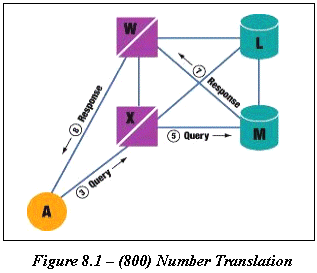| 8 APPENDIX IV |
  |
8.1 (800) Number Translation Example
People generally are familiar with the toll-free aspect
of (800) numbers, however these numbers have significant additional capabilities
made possible by the SS7 network. The (800) numbers are "virtual" telephone
numbers that are not assigned to the subscriber line itself, but used to
point to real telephone numbers. When a subscriber dials an 800 number,
it is a signal to the switch to suspend the call and seek further instructions
from a database. The database will provide either a real phone number to
which the call should be directed, or it will identify another network
(e.g., a long-distance carrier) to which the call should be routed for
further processing. While the response from the database could be the same
for every call (as, for example, if you have a personal 800 number), it
can be made to vary based on the calling number, the time of day, the day
of the week, or a number of other factors. Figure 8.1 shows how a (800)
call is routed, where:
-
Switch: - The exchange were a temporary connection between
two subscribers is established automatically for the duration of a call.
-
Signaling Transfer Point (STP): - A signaling point with
the function of transferring signaling messages from one signaling link
to another and considered exclusively from the viewpoint of the transfer.
-
Service Control Point (SCP): - The SCP contains most of the
service logic and data required for Intelligent Network services. It is
composed of independent software modules, which can be easily adapted and
combined to create new services.

-
A subscriber served by "Switch A" wants to reserve a rental
car at a company's nearest location. She dials the company's advertised
(800) number.
-
When the subscriber has finished dialing, "Switch A" recognizes
that this is a (800) call and that it requires assistance to handle it
properly.
-
"Switch A" formulates a (800) query message, including the
calling and called number and forwards it to either of its STPs (X or W)
over its "Switch A" link to that STP, in Figure 8.1
(AX).
-
"STP X" determines that the received query is an 800 query
and selects a database (L or M) suitable to respond to the query, in our
example "Database M".
-
"STP X" forwards the query to "SCP M" over the appropriate
link, in Figure 8.1 (MX).
-
"SCP M" receives the query, extracts the passed information,
and (based on its stored records) selects either a "real" telephone number
or a network (or both) to which the call should be routed.
-
"SCP M" formulates a response message with the information
necessary to properly process the call, addresses it to switch A, picks
a STP (X or W) and a "Switch A" link to use, in Figure
8.1 (MW), and routes the response.
-
"STP W" receives the response message, recognizes that it
is addressed to "Switch A", and routes it to "Switch A" over (AW).
-
"Switch A" receives the response and uses the information
to determine where the call should be routed, and proceeds to set up the
newly addressed call.
Copyright - 2000 Sun Microsystems
28 June 00
If you have any comments or queries, please
mail them to [email protected]
